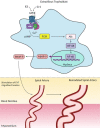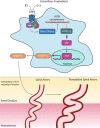Connecting G protein-coupled estrogen receptor biomolecular mechanisms with the pathophysiology of preeclampsia: a review
- PMID: 37393260
- PMCID: PMC10314559
- DOI: 10.1186/s12958-023-01112-7
Connecting G protein-coupled estrogen receptor biomolecular mechanisms with the pathophysiology of preeclampsia: a review
Abstract
Background: Throughout the course of pregnancy, small maternal spiral arteries that are in contact with fetal tissue undergo structural remodeling, lose smooth muscle cells, and become less responsive to vasoconstrictors. Additionally, placental extravillous trophoblasts invade the maternal decidua to establish an interaction between the fetal placental villi with the maternal blood supply. When successful, this process enables the transport of oxygen, nutrients, and signaling molecules but an insufficiency leads to placental ischemia. In response, the placenta releases vasoactive factors that enter the maternal circulation and promote maternal cardiorenal dysfunction, a hallmark of preeclampsia (PE), the leading cause of maternal and fetal death. An underexplored mechanism in the development of PE is the impact of membrane-initiated estrogen signaling via the G protein-coupled estrogen receptor (GPER). Recent evidence indicates that GPER activation is associated with normal trophoblast invasion, placental angiogenesis/hypoxia, and regulation of uteroplacental vasodilation, and these mechanisms could explain part of the estrogen-induced control of uterine remodeling and placental development in pregnancy.
Conclusion: Although the relevance of GPER in PE remains speculative, this review provides a summary of our current understanding on how GPER stimulation regulates some of the features of normal pregnancy and a potential link between its signaling network and uteroplacental dysfunction in PE. Synthesis of this information will facilitate the development of innovative treatment options.
Keywords: Angiogenesis; Estrogen; Extravillous trophoblast; GPER; Hypoxia; Preeclampsia; Pregnancy; Spiral arteries; Uteroplacental circulation.
© 2023. The Author(s).
Conflict of interest statement
The authors declare that they have no competing interests.
Figures


References
Publication types
MeSH terms
Substances
Grants and funding
LinkOut - more resources
Full Text Sources

